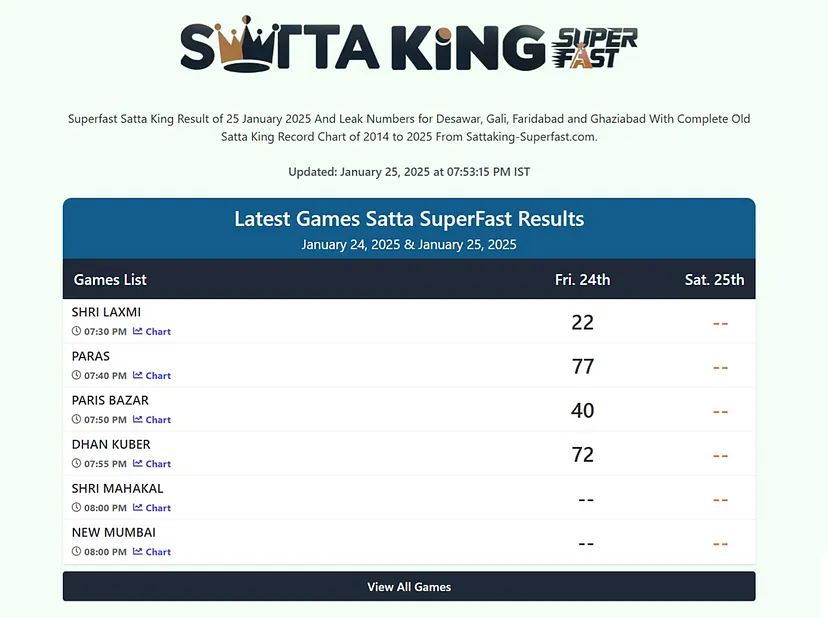The Rise and Fall of Satta Kings: Inside India’s Secret Gambling Empire
Introduction: The Shadow Lords of Luck In the labyrinthine alleys of Mumbai and the dusty lanes of Uttar Pradesh, whispers of Satta King once echoed like folklore. These enigmatic figures ruled India’s underground gambling empire, Satta Matka, amassing wealth, power, and mythic status. But their reign—built on luck, manipulation, and audacity—was as fleeting as the bets they oversaw. This article uncovers the legacy of Satta Kings, the mechanics of the game they popularized, and why this multi-crore industry remains a dangerous obsession for millions.
The Birth of Satta Matka: From Cotton to Kings
The story of Satta Matka begins not with kings but with cotton. In the 1950s, textile workers in Mumbai bet on cotton prices from the New York Cotton Exchange. When this system vanished in 1961, a vacuum emerged — one filled by pioneers like Ratan Khatri, the original Satta King.
Khatri transformed gambling into an art form. He replaced cotton rates with random numbers drawn from a matka (earthen pot). Players picked numbers, and winners earned 90x their stake. Khatri’s empire grew rapidly, with agents (bookies) operating in every corner of Mumbai. By the 1980s, he controlled 80% of the market, earning ₹500 crore annually. His lavish lifestyle — luxury cars, armed guards, and political connections — cemented his reputation as the undisputed Matka Monarch.
Other Satta Kings soon followed, like Kalyanji Bhagat and Suresh Bhagat, who expanded the game to states like Gujarat and Rajasthan. At its peak, Satta Matka handled ₹20,000 crore annually, rivaling corporate giants.
How Satta Works: The Game of Crores
Satta Matka’s simplicity is its genius. Here’s how it works:
- Betting Options: Players bet on numbers (e.g., 2, 5, 7) or combinations like Jodi (pair) or Patti (three-digit sequence).
- The Draw: Originally, numbers were pulled from a matka. Today, results mimic stock market indices (e.g., Mumbai’s Kalyan Matka uses imaginary market charts).
- Payouts: A ₹100 bet on a single number could win ₹9,000.
Bookies, often local influencers, act as middlemen. They take bets, keep a commission (pot), and funnel profits to their Satta King. Despite digitization, cash remains king — transactions are untraceable, and trust is enforced through fear.
The Satta Kings: Glory, Greed, and Downfall
The Satta Kings were both revered and feared. Ratan Khatri’s parties were legendary, attended by politicians and Bollywood stars. Kalyanji Bhagat, dubbed the Matka Messiah, donated to temples to legitimize his empire. But their power was precarious:
- Violence: Rival gangs often clashed. Suresh Bhagat was murdered in 2008 by his own son over a ₹1,000 crore dispute.
- Law Enforcement: Crackdowns in the 1990s dismantled physical matkas. Khatri was jailed, and his empire crumbled.
- Karma: Many Satta Kings died in obscurity, their wealth eroded by legal battles or addiction.
Yet, their legacy persists. Phrases like “Kalyan ka result aya kya?” (Is Kalyan’s result out?) still punctuate conversations in Mumbai’s chawls.
Cultural Impact: Bollywood, Slang, and Social Ruin
Satta Matka has seeped into India’s psyche:
- Bollywood Glamor: Films like Matka King (upcoming) and Gambler romanticize the Satta Kings’ rise.
- Street Slang: Terms like “Matka lagana” (to take a risk) are part of everyday vernacular.
- Tragedy: For every rags-to-riches story, there are tales of suicide, broken families, and lifelong debt.
In Uttar Pradesh, farmers bet their land; in Mumbai, drivers stake their daily earnings. A 2021 survey found 60% of players in Delhi’s slums borrowed from loan sharks, paying 20% weekly interest.
The Digital Era: New Kings, New Rules
With the decline of physical matkas, a tech-savvy generation of Satta Kings emerged. Websites like Satta King Online and DPBOSS use algorithms to generate results. Bets are placed via Telegram, WhatsApp, or apps disguised as gaming platforms. Cryptocurrencies like Bitcoin hide transactions, while VPNs bypass government bans.
Young entrepreneurs like “Raju Bhai,” a 28-year-old from Jaipur, boast of earning ₹10 lakh daily through online Satta. “It’s the Uber of gambling,” he claims. But unlike Uber, there’s no safety net — winners vanish if they refuse to share profits with the new-age Kings.
Why Satta Thrives: Desperation and Dreams
Three reasons fuel Satta’s immortality:
- Economic Inequality: Daily wage workers see it as their only escape from poverty.
- Community Complicity: Local bookies are often neighbors or relatives, normalizing the risk.
- The Myth of Control: Players believe in “formulas” to predict numbers, despite the game’s randomness.
As Ratan Khatri once said, “Satta isn’t about numbers — it’s about hope.”
Legality: A Cat-and-Mouse Game
Under the Public Gambling Act, Satta is illegal, yet enforcement is lax. Police raids target small bookies, while kingpins bribe their way to freedom. In 2023, Maharashtra’s Anti-Extortion Cell arrested a Satta Kingpin linked to ₹200 crore in monthly bets. Yet, hours later, his operations resumed via a Dubai-based app.
States like Sikkim and Goa legalize casinos for tourists, creating a paradoxical system where the rich gamble freely while the poor face jail for Satta.
Conclusion: The Eternal Dance with Destiny
The era of Satta Kings like Ratan Khatri may be over, but their empire lives on — digitized, decentralized, and deadlier. For millions, Satta remains a twisted lottery, offering fleeting riches at the cost of dignity, security, and sometimes life.
As India strides toward a $5 trillion economy, the desperation fueling Satta persists. The solution lies not in stricter laws alone but in addressing unemployment, financial literacy, and the allure of “easy money.” Until then, the crown of the Satta King will pass to new claimants, and the matka will keep spinning tales of ruin and redemption.
